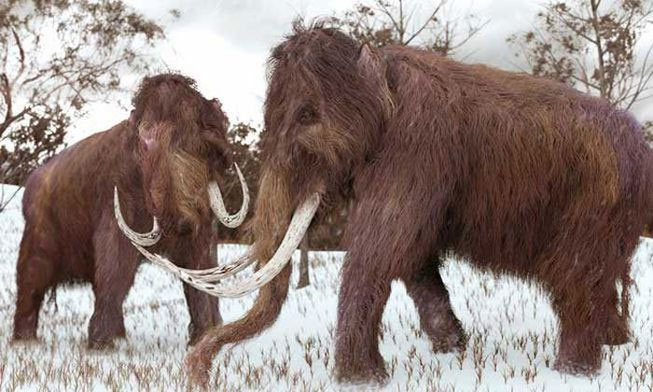Why does science have to spend tens of years just to revive mammoths?
Reviving mammoths - the largest elephant ever existed on Earth is an ambitious project of science. But is it really good to revive an extinct species of species for too long?
Although extinct more than 10,000 years ago, scientists have always tried to find many different ways to revive mammoths.
The question is: Why does science have to spend a lot of effort to revive this animal? Why not other creatures, like dinosaurs, for example. How does mammoth really play a big role?
Because science understands mammoths more than we thought
Beyond many other prehistoric species, mammoths are the most understandable human beings through fossil evidence. For example, the lifespan of mammoths is determined by the number of ivory circles (similar to the wood grain), or the role of mammoths in prehistoric life is extremely important.

Mammoths are the most understandable human animals through fossil evidence.
Because the more we know about mammoths, the more we want to conquer them. And the way to know more about mammoths is to revive them.
Revive from the "dead"
It must be affirmed that resurrection of mammoths is a very difficult and even impossible task. Scientists have come up with many different methods to revive this giant elephant. The most typical is the attempt to replicate genes, or to modify the structure of the Asian elephant gene from the mammoth original genome.
In 2011, a team of scientists from Japan, Russia and the United States used DNA from cold-preserved mammoth corpses to directly transplant into an African elephant's egg.
However, this method is difficult. Because even with the help of snow, the gene cells have gradually decomposed over time.
Harvard professor of science, George Church (USA), said: "The extreme impact of radiation for more than ten thousand years has certainly caused genes to be broken down into fragments. Therefore, their DNA loses its ability. work".
George Church's research team later also carefully conducted the implantation of mammoth genes into Asian elephant gene genes. They realized that mammoth genes could help elephants to increase their ability to circulate blood at low temperatures, enhance fat and hair growth - abilities that allow the body to adapt to cold conditions.
Once these preeminent features appear on tissues from stem cells, scientists will proceed to create a new embryo and cultivate it in an artificial uterus.

Reviving extinct creatures is an important part of the fight against climate change.
Extinct or revival?
The return of an extinct creature more than 10,000 years ago has given us a series of questions about humanity, and the purpose of reviving them.
The problem of reviving extinct creatures is an important part of the war. Ecologist Sergey Zimov said that bringing mammoths back to the environment could stimulate plants in the polar regions to grow stronger.
You should know that grassland is the area that has the best ability to lock carbon from the air. In addition, it helps ice and snow to stay longer in the winter, and limits the melting of ice in summer. As a result, carbon emissions to the atmosphere will be reduced.
Of course, this is only an ideal hypothesis. Biologist Helen Pilcher said: "We really can't imagine how reviving mammoths, they will live and communicate with the environment. We don't even know how to care for and nurture. How good will it be? It will take a long time for this hypothesis to succeed. "

Technical measures used to revive mammoths can help protect the species that are currently threatened.
Furthermore, even if science can revive mammoths, a cruel truth cannot be changed: it will take us more than half a century to help a herd of mammoths live safely in the world. The current.
But even so, technical measures used to revive mammoths can help protect the species that are currently threatened. Most notably, the project of Professor George Church successfully defended the North American weasel in danger of extinction because of inbreeding.
This rebirth project also has good and bad sides. On the one hand, primitive elephants will greatly contribute to biodiversity. However, scientists are concerned that resurgence of mammoths may adversely affect the ecological balance, affecting some other organisms.
And even biologist Stanley Temple from the University of Wisconsin (USA) shares frankly: "After all, revival action only helps science show. Think about it, if you revive the ghost. Successful sucking, the urgent actions to protect the species that are about to become extinct will become meaningless, and many species will be extinct, because everyone believes that science is able to revive them once. -half".
- Can revive mammoths
- More hope to revive mammoths
- Restoring mammoths from corpses
- Why need to revive the mammoth
- What will the world be like if dinosaurs and mammoths revive?
- Reviving mammoths
- Prehistoric mammoths are about to revive in 'Jurassic Park' in Russia?
- What do scientists do to revive dinosaurs?
- Resurrection of mammoths is at hand
- Mammoths can be 'revived'
- 12,000 years ago, two fighting mammoths came to wrap their tusks together, then died of starvation
- The mystery of the last years of mammoths
 Discovered an ancient centipede fossil 99 million years old
Discovered an ancient centipede fossil 99 million years old Discovered bat-like dinosaurs in China
Discovered bat-like dinosaurs in China Discovered a 200-year-old bronze cannon of the coast
Discovered a 200-year-old bronze cannon of the coast Discover 305 million-year-old spider fossils
Discover 305 million-year-old spider fossils